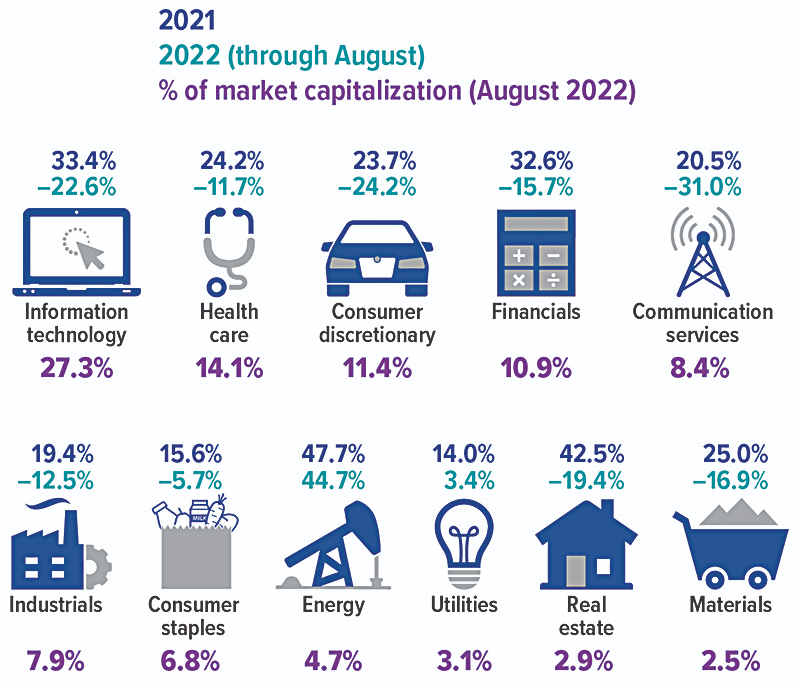The U.S. stock market had a banner year in 2021, with the S&P 500 index up almost 27%. Unfortunately, stocks turned downward on the second trading day of 2022 and kept sliding into a bear market. 1
Stocks in the S&P 500 are classified by 11 different business sectors, each of which responds differently to economic conditions. For example, the information technology sector was very strong in 2021, rising by 33.4%. But it turned south in 2022 and dropped by 22.6% through August. On the other hand, the energy sector, driven by high oil prices, was up during both periods (see chart).
Index Weighting
Many broad-based indexes, including the S&P 500, are weighted based on market capitalization — the total value of a company’s outstanding stocks. Sectors have different sizes and weighting to begin with, but the weight can change significantly due to performance. The information technology sector, which includes some of America’s largest companies, rose from about 20% of S&P 500 capitalization at the end of 2018 to 29% at the end of 2021, increasing its impact on the index when the sector turned downward. The financials sector dropped from 13.3% to 10.7% over the same period, decreasing its impact on the index.2

Source: S&P Dow Jones Indices, 2022 (data as of August 31). The S&P 500 is an unmanaged group of securities considered representative of the U.S. stock market in general. The performance of an unmanaged index is not indicative of the performance of any specific investment. Individuals cannot invest directly in an index. Past performance is not a guarantee of future results. Actual results will vary.
This means that even if you invest primarily in broad-based funds, you may be more heavily invested (overweight) or less invested (underweight) in a given sector than you realize. If you own more specific funds or individual stocks, your portfolio could be even more overweighted or underweighted.
Some market sectors — such as health care, consumer staples, and utilities — are considered “defensive” and may be good to hold through a bear market or economic recession because businesses in these sectors tend to remain strong regardless of economic conditions. Others — such as information technology and consumer discretionary — may have more growth potential but are more sensitive to economic conditions. Whether it’s appropriate to shift sector allocations in the middle of an economic cycle depends on your individual circumstances and long-term goals.
Sector Funds
One way to shift sector weight in your portfolio is by adding one or more sector funds — mutual funds or exchange-traded funds (ETFs) that focus on stocks of companies in a particular industry or sector of the economy. Because these funds are less diversified, they typically carry a higher level of volatility and risk than broad-based funds and should be considered as a complement to a core portfolio of diversified funds rather than a replacement.
Although sector funds offer flexibility in fine-tuning your portfolio, it’s important to resist the temptation to chase performance and move assets into “hot” sectors without a more comprehensive strategy. Sector performance is cyclical, and last year’s hot sector can easily turn cold, as can be seen in the ups and downs of technology stocks. Also keep in mind that every business cycle is different, and unexpected events can disrupt regular trends.
The return and principal value of all investments, including sector funds, fluctuate with changes in market conditions. Shares, when sold, may be worth more or less than their original cost. Asset allocation and diversification are methods used to help manage investment risk; they do not guarantee a profit or protect against investment loss.
Mutual funds and ETFs are sold by prospectus. Please consider the investment objectives, risks, charges, and expenses carefully before investing. The prospectus, which contains this and other information about the investment company, can be obtained from your financial professional. Be sure to read the prospectus carefully before deciding whether to invest.
If you have questions or need assistance, contact the Experts at Henssler Financial:
- Experts Request Form
- Email: experts@henssler.com
- Phone: 770-429-9166








